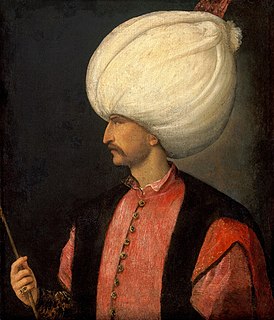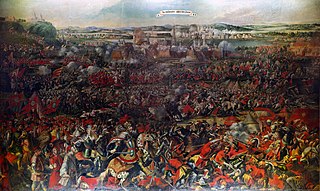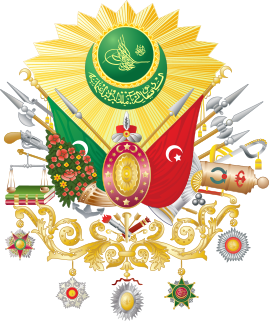
The Central Powers, also known as the Central Empires, was one of the two main coalitions that fought World War I (1914–18). It consisted of Germany, Austria-Hungary, the Ottoman Empire and Bulgaria; hence it is also known as the Quadruple Alliance. Colonies of these countries also fought on the Central Powers' side such as the Micronesia and German East Africa, until almost all of their colonies were occupied by Allies.

The Ottoman Empire was a state that controlled much of Southeastern Europe, Western Asia, and Northern Africa between the 14th and early 20th centuries. It was founded at the end of the 13th century in northwestern Anatolia in the town of Söğüt by the Turkoman tribal leader Osman I. After 1354, the Ottomans crossed into Europe and with the conquest of the Balkans, the Ottoman beylik was transformed into a transcontinental empire. The Ottomans ended the Byzantine Empire with the 1453 conquest of Constantinople by Mehmed the Conqueror. The Ottoman Empire would very slowly decline until its fall after World War I, in which it sided with the losing Central Powers of the German Empire, the Austro-Hungarian Empire, and Bulgaria.

Suleiman I, commonly known as Suleiman the Magnificent in the West and Suleiman the Lawgiver in his realm, was the tenth and longest-reigning Sultan of the Ottoman Empire from 1520 until his death in 1566. Under his administration, the Ottoman caliphate ruled over at least 25 million people.

The Crimean War was a military conflict fought from October 1853 to February 1856 in which Russia lost to an alliance made up of France, the Ottoman Empire, the United Kingdom and Sardinia. The immediate cause of the war involved the rights of Christian minorities in the Holy Land, then a part of the Ottoman Empire. The French promoted the rights of Roman Catholics, while Russia promoted those of the Eastern Orthodox Church. Longer-term causes involved the decline of the Ottoman Empire and the unwillingness of Britain and France to allow Russia to gain territory and power at the Ottoman Empire's expense. It has widely been noted that the causes, in one case involving an argument over a key, have never revealed a "greater confusion of purpose", yet they led to a war that stood out for its "notoriously incompetent international butchery".

The Battle of Vienna took place at Kahlenberg Mountain near Vienna on 12 September 1683 after the imperial city had been besieged by the Ottoman Empire for two months. The battle was fought by the Holy Roman Empire led by the Habsburg Monarchy and the Polish–Lithuanian Commonwealth, both under the command of King John III Sobieski, against the Ottomans and their vassal and tributary states. The battle marked the first time the Commonwealth and the Holy Roman Empire had cooperated militarily against the Ottomans, and it is often seen as a turning point in history, after which "the Ottoman Turks ceased to be a menace to the Christian world". In the ensuing war that lasted until 1699, the Ottomans lost almost all of Hungary to the Holy Roman Emperor Leopold I.

The fall of Constantinople was the capture of the Byzantine Empire's capital by the Ottoman Empire. The city fell on 29 May 1453, the culmination of a 53-day siege which had begun on 6 April 1453.

Mehmed V Reşâd reigned as the 35th and penultimate Ottoman Sultan. He was the son of Sultan Abdulmejid I. He succeeded his brother Abdul Hamid II after the Young Turk revolution. He was succeeded by his brother Mehmed VI. His nine-year reign was marked by the cession of the Empire's North African territories and the Dodecanese Islands, including Rhodes, in the Italo-Turkish War, the traumatic loss of almost all of the Empire's European territories west of Constantinople in the First Balkan War, and the entry of the Ottoman Empire into World War I in 1914, which would ultimately lead to the Empire's end.

The Ottoman dynasty was made up of the members of the imperial House of Osman, also known as the Ottomans. According to Ottoman tradition, the family originated from the Kayı tribe branch of the Oghuz Turks, under Osman I in northwestern Anatolia in the district of Bilecik Söğüt. The Ottoman dynasty, named after Osman I, ruled the Ottoman Empire from c. 1299 to 1922.

The Ottoman Interregnum, or the Ottoman Civil War, was a civil war in the Ottoman Empire between the sons of Sultan Bayezid I following the defeat of their father at the Battle of Ankara on 20 July 1402. Although Mehmed Çelebi was confirmed as sultan by Timur, his brothers İsa Çelebi, Musa Çelebi, Süleyman Çelebi, and later, Mustafa Çelebi, refused to recognize his authority, each claiming the throne for himself. Civil war was the result. The Interregnum lasted a little under 11 years, until the Battle of Çamurlu on 5 July 1413, when Mehmed Çelebi emerged as victor, crowned himself Sultan Mehmed I, and restored the empire.

Vlad II, also known as Vlad Dracul or Vlad the Dragon, was Voivode of Wallachia from 1436 to 1442, and again from 1443 to 1447. He is internationally known as the father of Vlad the Impaler, or Dracula. Born an illegitimate son of Mircea I of Wallachia, he spent his youth at the court of Sigismund of Luxembourg, who made him a member of the Order of the Dragon in 1431. Sigismund also recognized him as the lawful voivode of Wallachia, allowing him to settle in nearby Transylvania. Vlad could not assert his claim during the life of his half-brother, Alexander I Aldea, who acknowledged the suzerainty of the Ottoman Sultan, Murad II.

The Ottoman Caliphate, under the Ottoman dynasty of the Ottoman Empire, was the last Islamic caliphate of the late medieval and the early modern era. During the period of Ottoman expansion, Ottoman rulers claimed caliphal authority since the conquest of Mamluk Egypt by Selim I in 1517, which bestowed the title of Defender of the Holy Cities of Mecca and Medina upon him and strengthened the Ottoman claim to caliphate in the Muslim world.

The dissolution of the Ottoman Empire (1908–1922) began with the Second Constitutional Era with the Young Turk Revolution. It restored the Ottoman constitution of 1876 and brought in multi-party politics with a two stage electoral system under the Ottoman parliament. The constitution offered hope by freeing the empire's citizens to modernize the state's institutions and dissolve inter-communal tensions.

The Ottoman constitution of 1876 was the first constitution of the Ottoman Empire. Written by members of the Young Ottomans, particularly Midhat Pasha, during the reign of Sultan Abdul Hamid II (1876–1909), the constitution was in effect for only two years, from 1876 to 1878 in a period known as the First Constitutional Era. It was later put back into effect and amended to transfer more power from the sultan and the appointed Senate to the generally-elected Chamber of Deputies after the 1908 Young Turk Revolution, which initiated a period known as the Second Constitutional Era.

The Conquest of Tunis in 1535 was a successful capture of Tunis, then under the control of the Ottoman Empire, by the Habsburg Empire of Charles V and its allies.

Abdul Hamid II or Abdülhamid II reigned as the 34th Sultan of the Ottoman Empire - the last Sultan to exert effective control over the fracturing state. He oversaw a period of decline, with rebellions, and he presided over an unsuccessful war with the Russian Empire (1877–1878) followed by a successful war against the Kingdom of Greece in 1897. Abdulhamid II ruled from 31 August 1876 until his deposition shortly after the 1908 Young Turk Revolution, on 27 April 1909. In accordance with an agreement made with the Republican Young Ottomans, he promulgated the first Ottoman Constitution of 1876 on 23 December 1876, which was a sign of progressive thinking that marked his early rule. However, in 1878, citing disagreements with the Ottoman Parliament, he suspended both the short-lived constitution and the parliament.
Luna Mortis, formerly The Ottoman Empire, was an American heavy metal band based in Madison, Wisconsin.

The Franco-Ottoman alliance, also Franco-Turkish alliance, was an alliance established in 1536 between the king of France Francis I and the sultan of the Ottoman Empire Suleiman I. The strategic and sometimes tactical alliance was one of the most important foreign alliances of France, and was particularly influential during the Italian Wars. The Franco-Ottoman military alliance reached its peak around 1553 during the reign Henry II of France.
Curse of the Sun EP is the first EP released by the band The Ottoman Empire. It was self-released in 2004.
Prusa or Prousa, or Prusa near Olympus or Prusa under Olympus, was a town of ancient Bithynia or of Mysia, situated at the northern foot of Mysian Olympus. Pliny the Elder states that the town was built by Hannibal during his stay with Prusias I, which can only mean that it was built by Prusias, whose name it bears, on the advice of Hannibal. It is acknowledged by Dion Chrysostomus, who was a native of the town, that it was neither very ancient nor very large. It was, however, as Strabo remarks well governed, continued to flourish under the Roman emperors, and was celebrated for its warm baths that bore the name of the "royal waters." Under the Byzantine emperors it suffered much during the wars against the Ottoman Turks; when at last it fell into their hands, it was for a time the capital of their empire under the name of Bursa, which it still bears.















